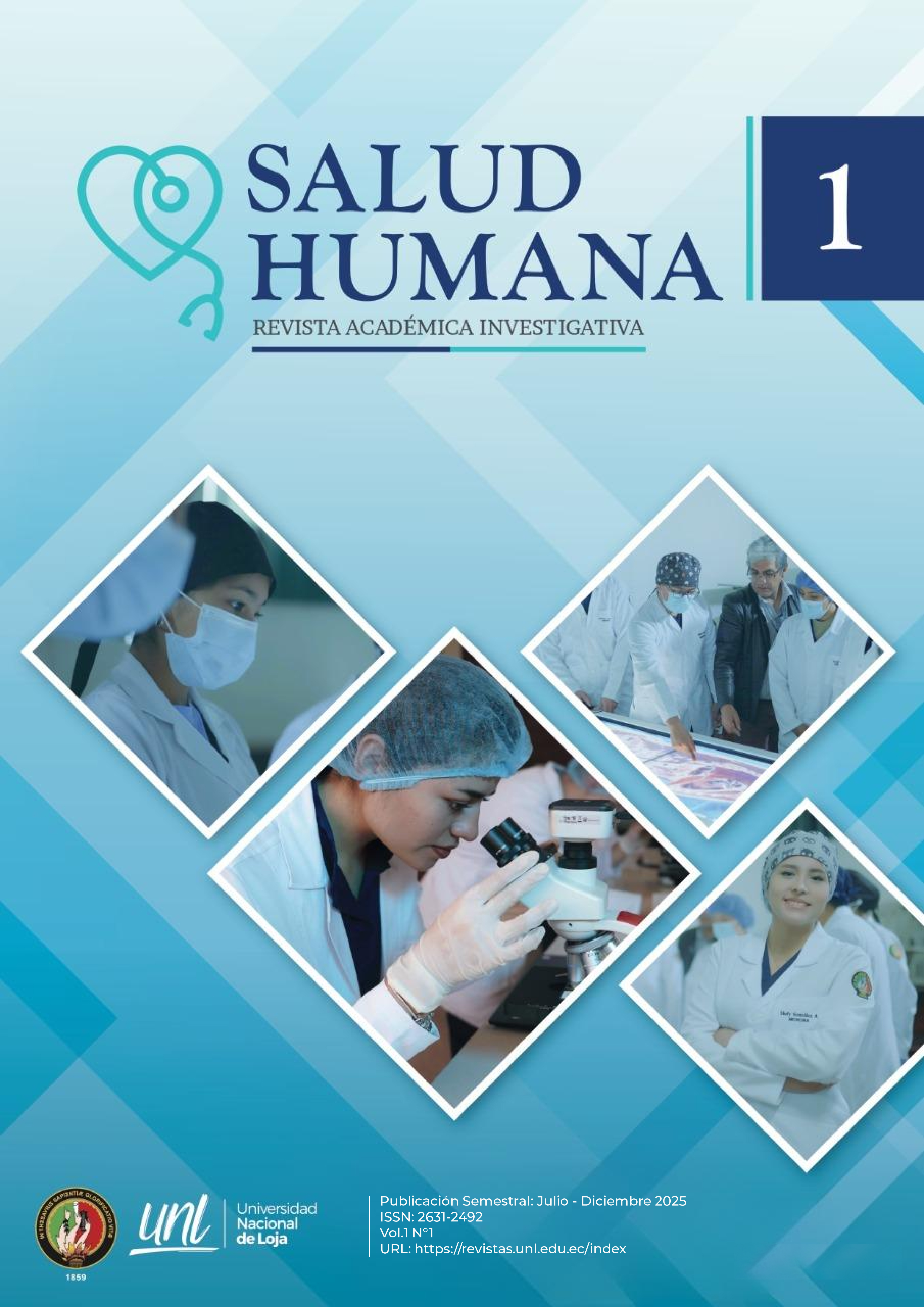Psychoemotional Load in Nursing Students: An Analysis of Stress, Anxiety and Depression.
Keywords:
Mental health, academic stress, anxiety, depression, college students, copingAbstract
Stress, anxiety and depression are frequent mental health problems in university students, especially in the nursing career, due to the high academic demands and clinical practices. This study aims to determine the levels of stress, anxiety and depression in students of the Technical University of Machala, identifying associated factors and proposing coping strategies. A quantitative, non-experimental, cross-sectional and descriptive research was conducted with a sample of 220 students selected by stratified sampling. The DASS-21 scale was applied to measure the levels of these emotional conditions. The results indicate that 43.2% of the students presented mild levels of emotional affectation, 36.8% moderate and 7.3% severe, with anxiety being the most prevalent condition with 71.9%. A significant relationship was observed between high levels of stress and academic load, as well as a higher prevalence in women. The discussion highlights the need to implement psychological support programs and coping strategies adapted to the characteristics of the students. It is concluded that stress, anxiety and depression affect the emotional well-being and academic performance of nursing students, so it is recommended to strengthen institutional mental health policies and promote activities that contribute to stress management and emotional stability in the university environmentReferences
[1] Cedeño-Meza, J. G., Maitta-Rosado, I. S., & Molina-Palma, S. E. (2021). Relación entre: estrés, ansiedad y rendimiento académico en estudiantes de psicología clínica. Ycs, 5(8 Ed. esp.), 80–93. https://editorialibkn.com/index.php/Yachasun/article/view/279
[2] Clerque Acuña, K. del P., Díaz Villarruel, J. J., & Cabascango Vinueza, D. J. (2024). Depresión, ansiedad y estrés en estudiantes universitarios post COVID-19 en la carrera de pedagogía de los idiomas nacionales y extranjeros. LATAM Revista Latinoamericana de Ciencias Sociales y Humanidades, 5(4), 1069–1080. https://latam.redilat.org/index.php/lt/article/view/2316
[3] Demera-Chica, A. D., Alcívar-González, N. D., & Cañarte-Murillo, J. R. (2024). El estrés y su relación con trastornos mentales en América Latina. MQRInvestigar, 8(1), 706–724. https://www.investigarmqr.com/ojs/index.php/mqr/article/download/912/3524
/4083
[4] Eslamimoghadam, F., Abedini, Z., & Khoramirad, A. (2024). The mental health of nursing students during the COVID-19 pandemic: Beneficial effects of mindfulness-based stress reduction. Heliyon, 10(12), e32986. http://dx.doi.org/10.1016/j.heliyon.2024.e32986
[5] Freitas, P. H. B. de, Meireles, A. L., Ribeiro, I. K. da S., Abreu, M. N. S., Paula, W. de, & Cardoso, C. S. (2023). Symptoms of depression, anxiety and stress in health students and impact on quality of life. Revista Latino-Americana de Enfermagem, 31, e3884. https://www.scielo.br/j/rlae/a/kSvsSfZmj8cHwXG38BJp8Zv/?lang=es
[6] Gambini López, I., Osorio Vidal, V. G., & Palomino Alca, J. T. (2024). El estrés académico en el aprendizaje de los estudiantes universitarios. Revistahorizontes, 8(32), 526–543. https://revistahorizontes.org/index.php/revistahorizontes/article/view/1357
[7] Guerra-Pino, J. M., & Reivan-Ortiz, G. G. (2024). Procrastinación y estrés académico en estudiantes universitarios ecuatorianos. MQRInvestigar, 8(3), 4893–4908. http://dx.doi.org/10.56048/mqr20225.8.3.2024.4893-4908
[8] Herrera Molina, A. S., et al. (2022). El profesional de enfermería en la promoción de salud en el segundo nivel de atención. REE, 16(1), 98–111. https://eugenioespejo.unach.edu.ec/index.php/EE/article/view/435
[9] Leonangeli, S., Michelini, Y., & Montejano, G. R. (2022). Depression, anxiety and stress in college students before and during the first three months of COVID-19 lockdown. Revista Colombiana de Psiquiatría. http://dx.doi.org/10.1016/j.rcp.2022.04.008
[10] Lovibond, S. H., & Lovibond, P. F. (1995). Escalas de ansiedad, estrés y depresión (DASS-21, DASS-42) [Registro de base de datos]. PsycTESTS.
[11] Marco-Ahulló, A., Villarrasa-Sapiña, I., & Monfort-Torres, G. (2021). Estudio descriptivo sobre las diferencias de género en el estrés académico derivado del contexto COVID-19. Retos Digitales, 43, 845–851. http://dx.doi.org/10.47197/retos.v43i0.88968
[12] Montalvo Prieto, A., & Simancas Pallares, M. A. (2019). Estrés y estrategias de afrontamiento en educación superior. Panorama Económico, 27(3), 655–674. http://dx.doi.org/10.32997/2463-0470-vol.27-num.3-2019-2586
[13] Organización Mundial de la Salud. (2022). Salud mental: fortalecer nuestra respuesta. WHO. https://www.who.int/es/news-room/fact-sheets/detail/mental-health-strengthening-our-response
[14] Organización Mundial de la Salud. (2023). Estrés. WHO. https://www.who.int/es/news-room/questions-and-answers/item/stress
[15] Responsabilidad legal en enfermería. (2021, aproximadamente). InfoSCARE – Revista para el profesional de la salud. Recuperado de https://revistainfoscare.com/responsabilidad-medico-legal/responsabilidad-legal-en-enfermeria/
[16] The Healthline Editorial Team. (2021). Estrés y ansiedad: Causas y cómo manejar el problema. Healthline. https://www.healthline.com/health/es/estres-y-ansiedad




